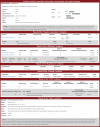CHDbase: A Comprehensive Knowledgebase for Congenital Heart Disease-related Genes and Clinical Manifestations
- PMID: 35961607
- PMCID: PMC10372913
- DOI: 10.1016/j.gpb.2022.08.001
CHDbase: A Comprehensive Knowledgebase for Congenital Heart Disease-related Genes and Clinical Manifestations
Abstract
Congenital heart disease (CHD) is one of themost common causes of major birth defects, with a prevalence of 1%. Although an increasing number of studies have reported the etiology of CHD, the findings scattered throughout the literature are difficult to retrieve and utilize in research and clinical practice. We therefore developed CHDbase, an evidence-based knowledgebase of CHD-related genes and clinical manifestations manually curated from 1114 publications, linking 1124susceptibility genes and 3591 variations to more than 300 CHD types and related syndromes. Metadata such as the information of each publication and the selected population and samples, the strategy of studies, and the major findings of studies were integrated with each item of the research record. We also integrated functional annotations through parsing ∼ 50 databases/tools to facilitate the interpretation of these genes and variations in disease pathogenicity. We further prioritized the significance of these CHD-related genes with a gene interaction network approach and extracted a core CHD sub-network with 163 genes. The clear genetic landscape of CHD enables the phenotype classification based on the shared genetic origin. Overall, CHDbase provides a comprehensive and freely available resource to study CHD susceptibilities, supporting a wide range of users in the scientific and medical communities. CHDbase is accessible at http://chddb.fwgenetics.org.
Keywords: Classification; Congenital heart defect; Congenital heart disease; Database; Genetics.
Copyright © 2023 The Authors. Published by Elsevier B.V. All rights reserved.
Conflict of interest statement
The authors have declared no competing interests.
Figures










Similar articles
-
CHDGKB: a knowledgebase for systematic understanding of genetic variations associated with non-syndromic congenital heart disease.Database (Oxford). 2020 Jan 1;2020:baaa048. doi: 10.1093/database/baaa048. Database (Oxford). 2020. PMID: 32608479 Free PMC article.
-
Genetics and Genomics of Congenital Heart Disease.Circ Res. 2017 Mar 17;120(6):923-940. doi: 10.1161/CIRCRESAHA.116.309140. Circ Res. 2017. PMID: 28302740 Free PMC article. Review.
-
Clinical and genetic findings in patients with congenital cataract and heart diseases.Orphanet J Rare Dis. 2021 May 31;16(1):242. doi: 10.1186/s13023-021-01873-7. Orphanet J Rare Dis. 2021. PMID: 34059112 Free PMC article.
-
Investigation of Genetic Causes in Patients with Congenital Heart Disease in Qatar: Findings from the Sidra Cardiac Registry.Genes (Basel). 2022 Jul 30;13(8):1369. doi: 10.3390/genes13081369. Genes (Basel). 2022. PMID: 36011280 Free PMC article.
-
Molecular insight into heart development and congenital heart disease: An update review from the Arab countries.Trends Cardiovasc Med. 2015 May;25(4):291-301. doi: 10.1016/j.tcm.2014.11.007. Epub 2014 Nov 20. Trends Cardiovasc Med. 2015. PMID: 25541328 Review.
Cited by
-
Systems analysis of de novo mutations in congenital heart diseases identified a protein network in the hypoplastic left heart syndrome.Cell Syst. 2022 Nov 16;13(11):895-910.e4. doi: 10.1016/j.cels.2022.09.001. Epub 2022 Sep 26. Cell Syst. 2022. PMID: 36167075 Free PMC article.
-
HAND1 level controls the specification of multipotent cardiac and extraembryonic progenitors from human pluripotent stem cells.EMBO J. 2025 May;44(9):2541-2565. doi: 10.1038/s44318-025-00409-0. Epub 2025 Mar 31. EMBO J. 2025. PMID: 40164946 Free PMC article.
-
Machine Learning in Identifying Marker Genes for Congenital Heart Diseases of Different Cardiac Cell Types.Life (Basel). 2024 Aug 19;14(8):1032. doi: 10.3390/life14081032. Life (Basel). 2024. PMID: 39202774 Free PMC article.
-
ENU-based dominant genetic screen identifies contractile and neuronal gene mutations in congenital heart disease.Genome Med. 2024 Aug 12;16(1):97. doi: 10.1186/s13073-024-01372-x. Genome Med. 2024. PMID: 39135118 Free PMC article.
-
Thymic Atrophy and Immune Dysregulation in Infants with Complex Congenital Heart Disease.J Clin Immunol. 2024 Feb 23;44(3):69. doi: 10.1007/s10875-024-01662-4. J Clin Immunol. 2024. PMID: 38393459 Free PMC article.
References
-
- Bernier P.L., Stefanescu A., Samoukovic G., Tchervenkov C.I. The challenge of congenital heart disease worldwide: epidemiologic and demographic facts. Semin Thorac Cardiovasc Surg Pediatr Card Surg Annu. 2010;13:26–34. - PubMed
-
- van der Linde D., Konings E.E., Slager M.A., Witsenburg M., Helbing W.A., Takkenberg J.J.M., et al. Birth prevalence of congenital heart disease worldwide: a systematic review and meta-analysis. J Am Coll Cardiol. 2011;58:2241–2247. - PubMed
-
- Oyen N., Poulsen G., Boyd H.A., Wohlfahrt J., Jensen P.K., Melbye M. Recurrence of congenital heart defects in families. Circulation. 2009;120:295–301. - PubMed
Publication types
MeSH terms
LinkOut - more resources
Full Text Sources
Medical

